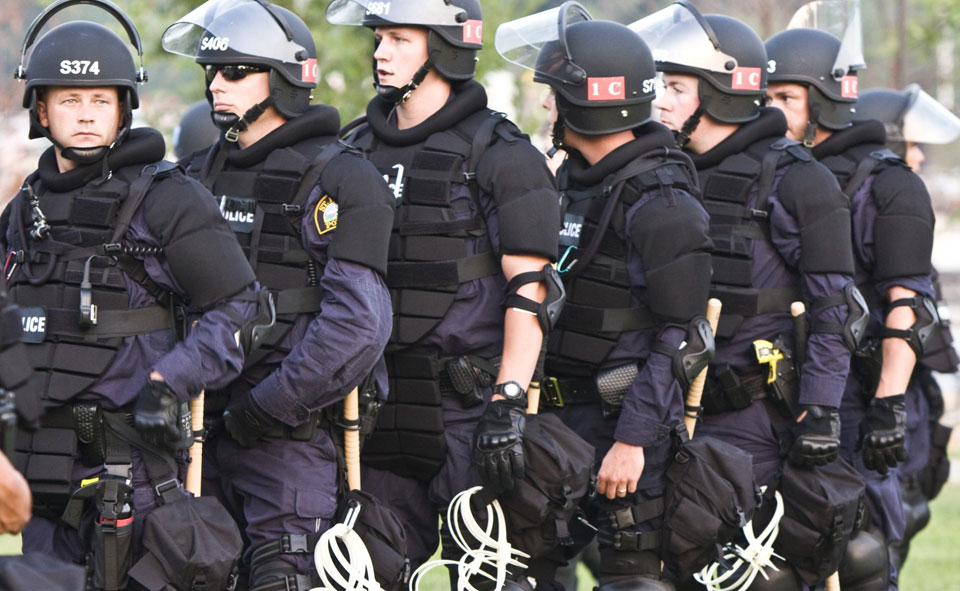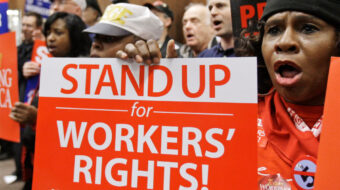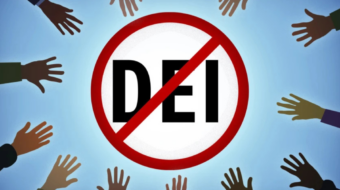
WASHINGTON—The labor movement is attempting to tackle head on the nationwide scourge of police violence and in particular the continued killing by cops of unarmed Black people. Labor leaders have a vision of an America where large numbers of heavily armed militarized police are never sent in to serve a summons on an unarmed Black man, like they were recently in North Carolina, resulting in his death.
They are proposing a union-crafted training program in community relations for police—including training in democratic principles and in diversity—more civilian help to take some duties off officers’ shoulders, and more community oversight are among the key recommendations of a new AFL-CIO panel’s report on relations between police and civilians, particularly civilians of color.
That means a federation panel said, also redirecting selected police calls to mental health counselors, social service workers, and other non-police specialists who can handle individual outbursts, leaving police to deal only with instances of actual crime. And it means ending a police culture of protecting one’s own.
It also means bringing the communities in to help fix the problems, including the structural racism and its impacts, rather than leaving communities out, the report says.
The Public Safety Blueprint For Change report just issued repeatedly recommends joint union-municipal or union-state collaboration on a wide range of measures to improve oversight and communications and protect officers who reveal misconduct or worse from retaliation.
Collaboration must also discover and implement ways to retrain police away from protecting each others’ backs when police abuse occurs and to eliminate conscious and unconscious bias. That includes weeding out racist recruits before they join the ranks.
The May 18 report from the federation’s civil rights task force subcommittee responds to the increase in police killings of unarmed Blacks. That focused attention—and massive protests nationwide—on systematic bias in the criminal justice system and among police in particular.
That in turn is part of U.S. society’s overriding larger problem of systemic bias against people of color in everything from jobs to housing to education to politics, the report admits. It did not deal with that larger systemic bias, though.
The subcommittee, chaired by Steelworkers Vice President Fred Redmond, with AFL-CIO Secretary-Treasurer Liz Shuler as #2, represented the federation’s 13 unions with police and law enforcement members, plus two non-AFL-CIO unions, the Teamsters and the Service Employees, that also house police units.
Other unions included the Government Employees—which represents ICE and the Border Patrol—AFSCME, which includes correctional officers, the Teachers (AFT), the California State Employees Association, the Communications Workers, the Machinists, the Painters, the Marine Engineers Beneficial Association, the Auto Workers, the Food and Commercial Workers and the Mine Workers. Unions that represent ICE and Border Patrol workers, although by far not the only ones, have many members influenced by racist and anti-immigrant ideas. Those two unions in particular have members who have played terrible roles on the nation’s southern border.
The thirteenth was the International Union of Police Associations, a small organization of police locals. The nation’s largest police group, the Federation of Police, is not a union and was not a member. The report’s introduction said it “is written by and from the perspective of unionized law enforcement officers and leaders, and endorsed by the participating unions and the AFL-CIO Task Force on Racial Justice.”
Some in the labor movement have called for expelling the police union from the AFL-CIO. Several Central Labor Councils and union sectors demand IUPA’s ouster from the AFL-CIO, given the record of police gunning down unarmed Blacks. Police also have a long history of being sent, at corporate behest, to break strikes and, in the early 20th century even kill strikers.
And in a fundraising e-mail, the Working Families Party stated police unions are actively working to defeat politicians who favor curbing police violence.
The report says, however, that, “With union members experiencing these tensions” between police and communities of color “in our nation firsthand, the labor movement (is) the single best vehicle for bringing police and community together.”
One reason for the chasm is “for far too long, people in positions of power—elected leaders and other decision-makers—stood idle while communities suffered under a system designed to benefit those with wealth and power at the expense of everyone else,” it adds.
“By allowing this system to fester from our nation’s conception, institutions that rely on community trust, such as police departments, became more and more disjointed from the communities they are charged with serving.
“This has been exacerbated by a culture in law enforcement that has discouraged the professionals doing the job correctly every day from calling out their peers whose actions are a detriment to maintaining peace and safety, the profession and the community relationships needed for success.”

That’s no surprise, the report adds. “Systemic racism has been used throughout history as a tool by those in power to divide workers, leading to the ‘us vs. them’ mentality dominating today’s political and social unrest.”
The result appeared in a Gallup poll last year, which reported 56% of respondents favored eliminating police unions. And though the report did not say so, police abuse led some states to consider eliminating “police bill of rights” laws. The first state to adopt one, Maryland, is in the process of repealing it.
To try to start to solve this mess, the report, at www.aflcio.org, has more than a dozen recommendations. Key ones include:
- Having locals implement a union program, Union Law Enforcement Accountability And Duty Standards (U-LEADS). State feds and Central Labor Councils should “take the initiative” to inform and work with communities to publicize U-LEADS and accountability.
The report calls U-LEADS “a mechanism independent of management to effectively deal with members who continually violated their oath of office and our relationships with the communities we serve.” Police unions, the report notes, often in such cases defend the officers and “are often blamed for defending the indefensible” and blocking reforms. U-LEADS would not only set standards for police to meet but is designed to protect whistleblowers, it said.
- Split up and spin off many of the calls police now get that don’t involve crime. Unions, communities, and police agencies “should expressly develop a comprehensive, differential response model…of the most effective strategies to handle emergency and service calls from the community.”
In plain English that means, figuring out which calls actually need a police response and which can be better handled by mental health and social service agencies. One key need, though, the report said: More money for those agencies to hire more professionals.
- The report was silent on cutting funds to police to pay for the alternatives. And it flatly rejected demands from various groups to “defund the police”—a charge the right-wing keeps hanging on its political foes, including workers.
“Officers spend their time responding to pressing problems” that go beyond enforcing laws or fighting crime—“overdoses, homelessness, and mental-health crises, to name a few.” Officers must “pick up the pieces of what society has failed at solving,” as “when no one else can help, we call the cops and ask them to do something,” the report declares.
”There is a need for large investments to create a civilian corps of unarmed first responders such as social workers, EMTs and trained mental health professionals who can work in partnership with police officers and handle nonviolent emergencies,” it adds.
“Differential police response strategies…systematically differentiate among requests for police service” and the best response. DPR means there’s “a wider range of responses….than the traditional one of dispatching patrol officers as quickly as possible.”
- Police “agencies should strive to create a workforce that contains a broad range of diversity including race, gender, language, life experience, and cultural background to improve understanding and effectiveness in dealing with all communities.”
- Train the police to, in so many words, obey the U.S. Constitution.
“Police have a significant amount of authority. Accordingly, it is essential they receive training on the constitutional basis of and the proper use of the power they are granted. Particular focus should be placed on ensuring that stops based on reasonable suspicion…are conducted in a fair and constitutional way,” it says.











